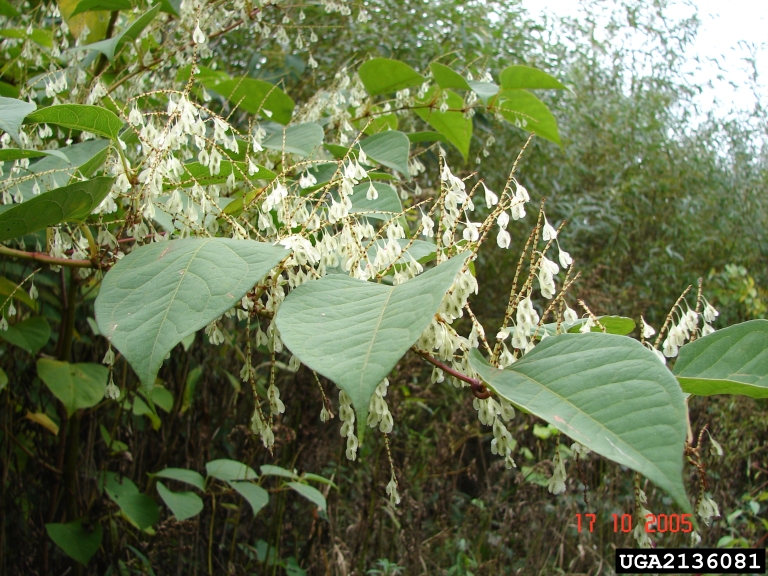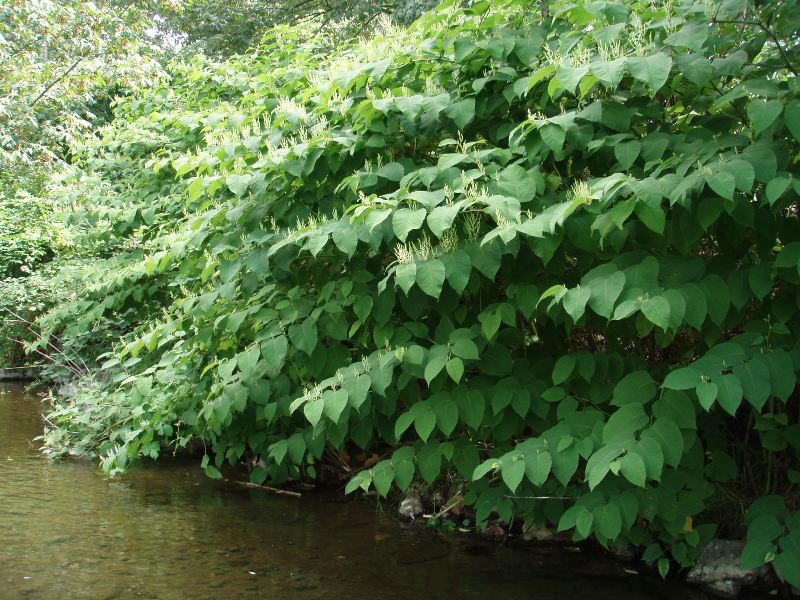
Plant Description
- Bamboo-like, green or reddish hollow stems
- Bright green leaves 1 to 10 inches wide with smooth (not saw-toothed) edges
- Starts growth in April; full size by June
- Spikes of small, white flowers in late summer
- Dead reddish-brown stems often remain standing during winter
- Dense stands up to 12 feet tall
- Knotweed thrives in any moist soil or river cobble, in full or partial sunlight
- Most common in the floodplains along rivers and creeks, also grows along roads and in yards
- Scientific Name: Polygonum cuspidate
History
Knotweed is a perennial plant introduced in the 19th century from Asia as an ornamental plant and for erosion control. It is native to northeastern Asia and is adapted to disturbed soils. It is one of the first plants to colonize volcanic slopes after volcanic activity.
Spread
Knotweed usually spreads when stem or root fragments are moved by floods. It is also spread through fill dirt containing root or stem fragments. Because fragments as small as ½ inch can start new plants, even one patch can produce hundreds of new plants.
Ecological Threats
Knotweed is fast growing and extremely aggressive. The spread of Japanese knotweed adversely impacts the complexity and diversity of native riparian vegetation. Japanese knotweed vigorously colonizes floodplain areas and if allowed to spread unchecked, reduces and ultimately displaces native riparian vegetation, reducing plant diversity, reducing shade over streams, increasing solar radiation and water temperature.
The root system is a loose network of rhizomes which has poor soil binding qualities not suited for stabilizing stream banks during flood events, increasing erosion potential and turbidity which adversely affects salmon spawning habitat.
The reduction of native trees over time will decrease the availability of woody debris, reducing available deep scour pools where salmon typically wait out periods of low flow and higher water temperatures. In addition, reduced native riparian vegetation caused by Japanese knotweed monocultures correlates to habitat loss for macro invertebrate species that represent an important link in the aquatic food chain on which juvenile salmon populations rely. Due to the vigorous root system, large patches are difficult to eradicate.
Potential Property Impacts
Knotweed can damage building foundations, sidewalks, driveways and roads. In worst-case scenarios, homeowners in the United Kingdom have been denied mortgages because of infestations on their property. Check your property and refer to the ‘How You Can Help’ page for more information on control, or contact our Invasive Species Coordinator by e-mail at [email protected] or call 360-992-8787.
Current Nationwide and Statewide Distribution
See USDA PLANTS database maps.
All four varieties (Japanese, Giant, Himalayan and Bohemian) are considered Washington State Class B noxious weeds and are required to be controlled in the Salmon Creek watershed.


